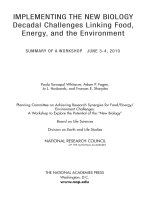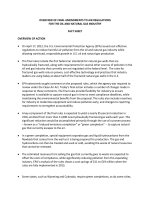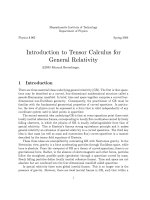introduction to proteomics tools for the new biology - daniel c. liebler
Bạn đang xem bản rút gọn của tài liệu. Xem và tải ngay bản đầy đủ của tài liệu tại đây (4.02 MB, 210 trang )
Introduction to
Humana Press
Daniel C. Liebler
Tools for the New Biology
Proteomics
i
INTRODUCTION TO PROTEOMICS
ii
iii
Introduction to Proteomics
Tools for the New Biology
By
D
ANIEL C. LIEBLER, PhD
College of Pharmacy
The University of Arizona
Tucson, AZ
Foreword by
JOHN R. YATES, III, PhD
Department of Cell Biology
The Scripps Research Institute
La Jolla, CA
Humana Press
Totowa, NJ
iv
© 2002 Humana Press Inc.
999 Riverview Drive, Suite 208
Totowa, New Jersey 07512
humanapress.com
For additional copies, pricing for bulk purchases, and/or information about other Humana
titles, contact Humana at the above address or at any of the following numbers: Tel.: 973-256-1699;
Fax: 973-256-8341, E-mail: ; or visit our Web
site at: www.humanapr.com
All rights reserved.
No part of this book may be reproduced, stored in a retrieval system, or transmitted in any form
or by any means, electronic, mechanical, photocopying, microfilming, recording, or otherwise
without written permission from the Publisher. The content and opinions expressed in this book
are the sole work of the authors and editors, who have warranted due diligence in the creation
and issuance of their work. The publisher, editors, and authors are not responsible for errors or
omissions or for any consequences arising from the information or opinions presented in this
book and make no warranty, express or implied, with respect to its contents.
Cover design by Patricia Cleary.
Production Editor: Kim Hoather-Potter.
This publication is printed on acid-free paper. ∞
ANSI Z39.48-1984 (American National Standards Institute) Permanence of Paper for Printed
Library Materials.
Photocopy Authorization Policy:
Authorization to photocopy items for internal or personal use, or the internal or personal use of
specific clients, is granted by Humana Press Inc., provided that the base fee of US $10.00 per
copy, plus US $00.25 per page, is paid directly to the Copyright Clearance Center at 222
Rosewood Drive, Danvers, MA 01923. For those organizations that have been granted a pho-
tocopy license from the CCC, a separate system of payment has been arranged and is
acceptable to Humana Press Inc. The fee code for users of the Transactional Reporting Service
is: [0-89603-991-9/02 $10.00 + $00.25].
Printed in the United States of America. 10 9 8 7 6 5 4 3 2 1
Library of Congress Cataloging-in-Publication Data
Liebler, Daniel C.
Introduction to proteomics: tools for the new biology/Daniel C. Liebler.
p. cm.
Includes bibliographical references and index.
ISBN 0-89603-991-9 (HC), ISBN 0-89603-992-7 (PB) (alk. paper)
1. Proteins—Research—Methodology. I. Title.
QP551.L467 2002
572'.6'072—dc21 2001051465
v
Foreword
Mass spectrometry has evolved tremendously since Professor Klaus
Biemann first analyzed amino acids in a mass spectrometer in 1958.
The clear challenge in Biemann’s first experiment was how to intro-
duce nonpolar molecules into the mass spectrometer to create ions. In
the years since 1958, several new ionization techniques and sample
introduction methods appeared and stimulated much progress in the
analysis of biomolecules. As these new ionization techniques, such as
chemical ionization, field desorption, field ionization, plasma desorp-
tion, and finally fast atom bombardment (FAB) emerged, new methods
for peptide and protein characterizations also developed. Mass spec-
trometry technology leapt forward in 1987 with the introduction of
matrix-assisted laser desorption ionization (MALDI) and the applica-
tion of electrospray ionization (ESI) to biomolecules. Both ionization
methods led to dramatic improvements in the analysis of peptides and
proteins. A key mass spectrometry technique that benefited from the
new ionization methods was tandem mass spectrometry.
In the early 1980s Professor Donald Hunt began developing and
applying tandem mass spectrometry to the sequence analysis of pep-
tides and proteins. FAB, a soft ionization technique, created intact proto-
nated molecules and allowed the refinement of approaches for peptide
sequencing. FAB was a major breakthrough for peptide sequencing,
because peptides could now be readily ionized without derivatization
to increase volatility. By incorporating FAB with tandem mass spec-
trometry, a rapid peptide sequencing methodology was developed.
Most approaches used off-line HPLC separations when complicated
peptide mixtures were encountered. Many proteins were sequenced
by this approach and many important methods were developed.
Unfortunately, on-line coupling of separation methods with FAB was
never able to create a robust, easy-to-use method. This problem wasn’t
resolved until electrospray ionization facilitated the direct coupling of
separation techniques to the mass spectrometer. All aspects of peptide
and protein analyses were improved by increases in the sensitivity of
analysis, easier sample handling, and automation.
v
vi
These developments in mass spectrometry dovetailed very nicely
into the worldwide efforts to sequence the human genome. The
genome sequencing efforts encompassed not only the human genome,
but also genomes of many model organisms and have resulted in the
generation of a large amount of sequence information. In 1993 several
groups discovered that mass spectrometry data could be used to search
databases to identify the protein under study. In 1994 methods to search
sequence databases using tandem mass spectrometry data were
developed allowing one to “look up the answer in the back of the book.”
If the “book” was an organism whose genome was sequenced, then
the answer was most assuredly in the back. The complex issues of post-
translational modifications and amino acid sequence variations can also
be addressed by knowing the sequences of proteins from a genome
sequence.
Interest in and use of mass spectrometry in the biological sciences
has grown rapidly during the 1990s and threatens to become as ubiq-
uitous and important as SDS-PAGE in the new millennium. Biologists
will come to rely on mass spectrometry to determine the outcomes of
their experiments. Given the need for biologists to use mass spectrom-
etry technology to analyze their experiments, how does a biologist learn
about the art of mass spectrometry and the methods of proteomics?
This book, Introduction to Proteomics: Tools for the New Biology by Pro-
fessor Daniel Liebler, presents a tutorial on mass spectrometry and its
use in proteomics. The basics of mass spectrometers and ionization
techniques are described, which is important to ascertain what type of
mass spectrometer is most appropriate for a particular study. The abil-
ity to use mass spectrometry data to search databases is an important
advance for the nonspecialist, because it no longer requires the devel-
opment of the skills to interpret mass spectra. A basic understanding
of the fundamentals of the search algorithms and their limitations is
described in the book. Finally, applications of mass spectrometry to
proteomics are described. This book provides an excellent introduction
and overview of proteomics for the graduate student or for any biolo-
gist interested in understanding the basics of this rapidly evolving area.
John R. Yates, III
Scripps Research Institute
La Jolla, CA
Foreword
vii
Preface
This book is an introduction to the new field of proteomics. It is
intended to describe how proteins and proteomes can be analyzed and
studied. Despite widespread, growing interest in proteomics, an
understanding of proteomics tools and technologies is only slowly pen-
etrating the research community at large. This book addresses the need
to introduce biologists to new tools and approaches, and is for both
students of biology and experienced, practicing biologists. Anyone who
has taken a graduate level biochemistry course should be able to take
from this book a reasonable understanding of what proteomics is all
about and how it is practiced. The experienced biologist should en-
counter much here that is familiar, but refocused to facilitate studies of
the proteome.
The achievement of long-sought milestones in genome sequencing,
analytical instrumentation, computing power, and user-friendly software
tools has irrevocably changed the practice of biology. After years of study-
ing the individual components of living systems, we can now study the
systems themselves in comprehensive scope and in exquisite molecular
detail. We therefore face the tasks of effectively employing new tech-
nologies, of dealing with mountains of data, and, most important, of
adjusting our thinking to understand complex systems as opposed to
their individual components.
Introduction to Proteomics: Tools for the New Biology had its origins in a
short course on peptide sequencing by mass spectrometry, which was
taught by Dr. Donald F. Hunt at the 1998 Association of Biomedical
Resource Facilities meeting in Durham, North Carolina. At that time,
my colleague Dr. Tom McClure and I were establishing a new proteomics
facility in the Center for Toxicology and the Arizona Cancer Center at
the University of Arizona. Tom attended the Hunt course and, upon his
return, taught the material to a handful of us. We subsequently put
together a four-day workshop on mass spectrometry and proteomics,
which we taught to 50 participants at the University of Arizona in
August, 1999. The participants included graduate students, laboratory
staff, and faculty. The enthusiastic response to this workshop reflected
the need for some accessible means of introducing scientists to the new
vii
viii
techniques of proteomics and their potential applications in research.
That experience provided the impetus for this book.
This is a book for beginners. My goal here is to familiarize the inexpe-
rienced reader with the important tools and applications of proteomics.
Thus the description of certain instrumentation and applications is not
highly rigorous. This book is not intended to be a laboratory manual or
a compilation of the latest techniques. There are several excellent vol-
umes available that provide more detailed descriptions of protein ana-
lytical techniques, mass spectrometry instrumentation and techniques,
and applications of these technologies. The evolution of methods and
applications in this area is now so rapid that no book really could be
truly up-to-date. What is exciting about my experience in introducing
proteomics to colleagues has been the creativity with which they then
apply these tools. Ultimately, the exciting potential of proteomics rests
with those who can put new technologies to work to address impor-
tant questions.
I have divided the book into three parts. Part I introduces the sub-
ject of proteomics, describes its place in the new biology, and examines
the nature of proteomes. Part II introduces the tools of proteomics
research and explains how they work. Part III explains how these tools
are integrated to solve different types of problems in biology.
I would like to thank Jeanne Burr, Laura Tiscareno, Julie Jones, Dan
Mason, Beau Hansen, Hamid Badghisi, Linda Manza, Richard
Vaillancourt, Tom McClure, Arpad Somogyi, and George Tsaprailis, who
provided valuable suggestions, read and commented on several drafts
of book chapters and provided sample data for some of the illustrations.
I thank Elizabeth Hedger for excellent secretarial assistance. Finally, I
thank my wife Karen and my son Andrew for their patience with me
every time I went off with my laptop to write.
Daniel C. Liebler, PhD
Preface
ix
Contents
Foreword by J. R. Yates, III v
Preface vii
I. Proteomics and the Proteome 1
1. Proteomics and the New Biology 3
2. The Proteome 15
II. Tools of Proteomics 25
3. Overview of Analytical Proteomics 27
4. Analytical Protein and Peptide Separations 31
5. Protein Digestion Techniques 49
6. Mass Spectrometers for Protein and Peptide Analysis 55
7. Protein Identification by Peptide Mass Fingerprinting 77
8. Peptide Sequence Analysis by Tandem
Mass Spectrometry 89
9. Protein Identification with Tandem Mass
Spectrometry Data 99
10. SALSA: An Algorithm for Mining Specific Features
of Tandem MS Data 109
III. Applications of Proteomics 123
11. Mining Proteomes 125
12. Protein Expression Profiling 137
13. Identifying Protein–Protein Interactions
and Protein Complexes 151
14. Mapping Protein Modifications 167
15. New Directions in Proteomics 185
Index 195
ix
huangzhiman 2002.12.19
Proteomics and New Biology 1
I
Proteomics
and the Proteome
2 Proteomics and the Proteome
Proteomics and New Biology 3
1
Proteomics and the New
Biology
From: Introduction to Proteomics: Tools for the New Biology
By: D. C. Liebler © Humana Press, Inc., Totowa, NJ
3
1.1. The New Biology
Proteomics is the study of the proteome, the protein complement of
the genome. The terms “proteomics” and “proteome” were coined by
Marc Wilkins and colleagues in the early 1990s and mirror the terms
“genomics” and “genome,” which describe the entire collection of
genes in an organism. These “-omics” terms symbolize a redefinition
of how we think about biology and the workings of living systems
(Fig. 1). Until the mid-1990s, biochemists, molecular biologists, and cell
biologists studied individual genes and proteins or small clusters of
related components of specific biochemical pathways. The techniques
then available—Northern blots (for gene expression) and Western
blots (for protein levels)—made charting the status of more than a
handful of genes or proteins a formidable analytical task.
Three developments changed the biological landscape and formed
the foundation of the new biology. The first was the growth of gene,
expressed sequence tag (EST), and protein-sequence databases during
the 1990s. These resources became ever more useful as partial catalogs
of expressed genes in many organisms. The genome-sequencing
projects of the late 1990s yielded complete genomic sequences of
bacteria, yeast, nematodes, and drosophila and culminated recently
in the complete sequence of the human genome. Sequences of plant
genomes and those of other widely studied animals also are recently
completed or are approaching completion. These genome-sequence
4 Proteomics and the Proteome
databases are the catalogs from which much of our understanding of
living systems eventually will be extracted.
The second key development is the introduction of user-friendly,
browser-based bioinformatics tools to extract information from these
databases. It is now possible to search entire genomes for specific
nucleic acid or protein sequences in seconds. Such database search
tools are integrated with other tools and databases to predict the
functions of the protein products based on the occurrence of specific
functional domains or motifs. This array of free web-based tools now
enables the biologist to probe structures and functions of genes and
gene products and to explore a great deal of interesting biochemistry
right from a desktop computer.
The third key development is the oligonucleotide microarray. The
array contains a series of gene-specific oligonucleotides or cDNA
sequences on a slide or a chip. By applying a mixture of fluorescently
labeled DNAs from a sample of interest to the array, one can probe
Fig. 1. Biochemical context of genomics and proteomics.
Proteomics and New Biology 5
the expression of thousands of genes at once. One array can replace
thousands of Northern-blot analyses and can be done in the time it
would take to do one Northern. Moreover, with two-color fluorescent
probe labeling, expression of genes in two different samples can be
compared directly on one slide or chip.
An array slide containing unique sequences for each of the 6000
genes in the Sacchromyces cerevisiea genome is pictured in Fig. 2. From
Fig. 2. The yeast genome on a chip. This yeast cDNA microarray
was produced by the laboratory of Dr. Patrick Brown at Stanford
University ( />6 Proteomics and the Proteome
this single array, one can assess the expression of all genes in the yeast
genome. Such pictures vividly confront us with the greatest challenge
of the new biology. We can see the whole system, but the information
contained in these thousands of data points is beyond our ability
to interpret intuitively. New clustering algorithms, self-organizing
maps, and similar tools represent the latest approaches to rendering
the data in ways that biologists can comprehend.
The most important thing about arrays in this context is that they
have challenged biologists to think big. A cell has thousands or tens of
thousands of genes that may be expressed in varying combinations.
The life and death of cells is dictated by the expression of these genes
and the activities of their protein products. Each protein, whether a
transmembrane receptor, a transcription factor, a protein kinase, or a
chaperone, expresses a function that assumes significance only in the
context of all the other functions and activities also being expressed
in the same cell. Thus, biologists are now struggling to think big,
to understand systems rather than just components, and to make
sense of complexity.
1.2. Proteomics? That’s Just What We Used
to Call Protein Chemistry!
A common response to new ideas, terms, and approaches is to claim
that they are not really new after all. For this reason, it is important
to explain just what are the differences between proteomics and
protein biochemistry. Both proteomics and protein chemistry involve
protein identification, so what’s the difference? Table 1 provides a
short summary of the key features to consider. Protein chemistry
involves the study of protein structure and function and is most
commonly manifest in the fields of physical biochemistry or mecha-
nistic enzymology. The work generally involves complete sequence
analysis, structure determination, and modeling studies to explore
how structure governs function. Physical biochemists and enzymolo-
gists typically study one protein or multisubunit protein complex
at a time.
Proteomics is the study of multiprotein systems, in which the focus
is on the interplay of multiple, distinct proteins in their roles as part
of a larger system or network. Analyses are directed at complex
mixtures and identification is not by complete sequence analysis,
Proteomics and New Biology 7
but instead by partial sequence analysis with the aid of database
matching tools. The context of proteomics is systems biology, rather
than structural biology. In other words, the point of proteomics is
to characterize the behavior of the system rather than the behavior
of any single component.
1.3. If We Can Measure Gene Expression, Why
Bother With Proteomics?
Gene microarrays offer a snapshot of the expression of many or all
genes in a cell. Unfortunately, the levels of mRNAs do not necessarily
predict the levels of the corresponding proteins in a cell. Differing
stability of mRNAs and different efficiencies in translation can
affect the generation of new proteins. Once formed, proteins differ
significantly in stability and turnover rates. Many proteins involved
in signal transduction, transcription-factor regulation, and cell-cycle
control are rapidly turned over as a means of regulating their activities.
Finally, mRNA levels tell us nothing about the regulatory status
of the corresponding proteins, whose activities and functions are
subject to many endogenous posttranslational modifications and
other modifications by environmental agents.
1.4. Proteomics: An Analytical Challenge
The problem of how to measure the expression of many or all of the
genes in an organism simultaneously seems to have been solved by
the introduction of cDNA or oligonucleotide microarrays. Analysis
of gene expression by microarrays and related methods relies on two
essential tools, polymerase chain reaction (PCR) and hybridization of
Table 1
Differences Between Protein Chemistry and Proteomics
Protein chemistry Proteomics
• Individual proteins • Complex mixtures
• Complete sequence analysis • Partial sequence analysis
• Emphasis on structure and function • Emphasis on identification
by database matching
• Structural biology • Systems biology
8 Proteomics and the Proteome
oligonucleotides to complementary sequences. Unfortunately, there
are no analogous tools available for protein analysis. First, there
is no protein equivalent of PCR. It is not currently possible to induce
polypeptide molecules to replicate themselves in a manner ana-
logous to oligonucleotide replication through PCR. Whereas a small
amount of oligonucleotide can be amplified through PCR, a small
amount of a polypeptide must be detected and analyzed without
any amplification.
Second, proteins do not specifically hybridize to complementary
amino acid sequences. Watson-Crick base-pairing allows oligonucle-
otides to hybridize to complementary sequences. A defined comple-
mentary oligonucleotide sequence can serve as a highly specific
probe to which a specific mRNA or other nucleic acid fragment can
bind. This specificity allows a particular spot on the microarray to
recognize a unique sequence. Although antibodies and oligonucleotide
aptamers can recognize specific peptides or proteins, recognition
cannot be predicted simply on the basis of sequence, as it can for
oligonucleotides.
Another problem peculiar to proteomics is that each protein gene
product does not necessarily give rise to only one molecular entity in
the cell. This is because proteins are posttranslationally modified. The
extent and variety of modification varies with individual proteins,
regulatory mechanisms within the cell, and environmental factors.
Consequently, many proteins are present in multiple forms. The
necessity of detecting and differentiating between multiple protein
products of any particular gene adds much to the analytical challenge
of proteomics.
Analysis of the proteome thus requires a different set of tools
than does gene-expression analysis. The task of characterizing the
proteome requires analytical methods to detect and quantify proteins
in their modified and unmodified forms. How we deal with this task
is the subject of this book.
1.5. Tools of Proteomics
Despite the relative disadvantages of analytical proteomics described
earlier, the task of characterizing the proteome and its components
is now practically achievable. This is because the development and
integration of four important tools provide investigators with sensitive,
specific means of identifying and characterizing proteins.
Proteomics and New Biology 9
The first tool is the database. Protein, EST, and complete genome-
sequence databases collectively provide a complete catalog of all
proteins expressed in organisms for which the databases are available.
Based on analyses of all the coding sequences for Drosophila, for
example, we know that there are 110 Drosophila genes that code for
proteins with EGF-like domains and 87 genes that code for proteins
with tyrosine kinase catalytic domains. Accordingly, when doing
proteomics in Drosophila, we are searching a large, but known index of
possible proteins. When searched with limited sequence information
or even raw mass spectral data (see below), we can identify a protein
component from a match with a database entry.
The second tool is mass spectrometry (MS). MS instrumentation
has undergone tremendous change over the past decade, culminating
in the development of highly sensitive, robust instruments that can
reliably analyze biomolecules, particularly proteins and peptides. MS
instrumentation can offer three types of analyses, all of which are
highly useful in proteomics. First, MS can provide accurate molecular
mass measurements of intact proteins as large as 100 kDa or more.
Thus, MS analysis, rather that migration on sodium dodecyl sulfate-
polyacrylamide gel electrophoresis (SDS-PAGE) is the best way to
estimate protein masses. Highly accurate protein mass measurements
generally are of limited utility, however, because they often are not
sufficiently sensitive and because net mass often is insufficient for
unambiguous protein identification. MS also can provide accurate
mass measurements of peptides from proteolytic digests. In contrast
to whole protein mass measurements, peptide mass measurements
can be done with higher sensitivity and mass accuracy. The data
from these peptide mass measurements can be searched directly
against databases, frequently to obtain definitive identification of the
target proteins. Finally, MS analyses can provide sequence analysis
of peptides obtained from proteolytic digests. Indeed, MS is now
considered the state-of-the-art in peptide-sequence analysis. MS
sequence data provide the most powerful and unambiguous approach
to protein identification.
The third essential tool for proteomics is an emerging collection of
software that can match MS data with specific protein sequences in
databases. As noted earlier, it is possible to determine the sequence of
a peptide from MS data. However, this de novo sequence interpreta-
tion is a relatively laborious task, particularly when one has to
10 Proteomics and the Proteome
interpret hundreds or thousands of spectra. These software tools take
uninterpreted MS data and match it to sequences in protein, EST, and
genome-sequence databases with the aid of specialized algorithms.
The most useful aspect of these tools is that they permit the automated
survey of large amounts of MS data for protein-sequence matches. The
investigator then can inspect the results and evaluate the quality of
the data in far less time than it would take to interpret each spectrum
manually.
The fourth essential tool in proteomics is analytical protein-separation
technology. Protein separations serve two purposes in proteomics.
First, they simplify complex protein mixtures by resolving them into
individual proteins or small groups of proteins. Second, because they
also permit apparent differences in protein levels to be compared
between two samples, protein analytical separations allow investiga-
tors to target specific proteins for analysis. Certainly, two-dimensional
SDS-PAGE (2D-SDS-PAGE) is most widely associated with proteomics.
Two -dimensional gels represent perhaps the best single technique
for resolving proteins in a complex sample. However, other protein-
separation techniques, including 1D-SDS-PAGE, high-performance
liquid chromatography (HPLC), capillary electrophoresis (CE), iso-
electric focusing (IEF), and affinity chromatography all can be useful
tools in analytical proteomics. Perhaps most powerful is the integra-
tion of different protein and peptide separations as multidimensional
techniques. For example, ion-exchange liquid chromatography (LC) in
tandem with reverse-phase (RP)-HPLC is a powerful tool for resolving
complex peptide mixtures.
It is the integration of these four tools that provides the current
technology of proteomics. Each of these capabilities is rapidly evolving
from a technical standpoint. We will consider each of these sets of
analytical tools in subsequent chapters in this book.
1.6. Applications of Proteomics
Proteomics technology is indeed impressive, but what does char-
acterizing the proteome amount to in practical terms? In current
practice, proteomics encompasses four principal applications. These
are: 1) mining, 2) protein-expression profiling, 3) protein-network
Proteomics and New Biology 11
mapping, and 4) mapping of protein modifications. These each will
be defined briefly below and in detail in subsequent chapters in
this book.
Mining is simply the exercise of identifying all (or as many as
possible) of the proteins in a sample. The point of mining is to catalog
the proteome directly, rather than to infer the composition of the
proteome from expression data for genes (e.g., by microarrays). Mining
is the ultimate brute-force exercise in proteomics: one simply resolves
proteins to the greatest extent possible and then uses MS and associ-
ated database and software tools to identify what is found. There are
several approaches to mining and each offers advantages. What these
approaches collectively offer is the ability to confirm by direct analysis
what could only be inferred from gene-expression data.
Protein-expression profiling is the identification of proteins in a
particular sample as a function of a particular state of the organism
or cell (e.g., differentiation, developmental state, or disease state) or
as a function of exposure to a drug, chemical, or physical stimulus.
Expression profiling is actually a specialized form of mining. It is
most commonly practiced as a differential analysis, in which two
states of a particular system are compared. For example, normal and
diseased cells or tissues can be compared to determine which proteins
are expressed differently in one state compared to the other. This
information has tremendous appeal as a means of detecting potential
targets for drug therapy in disease.
Protein-network mapping is the proteomics approach to determin-
ing how proteins interact with each other in living systems. Most
proteins carry out their functions in close association with other
proteins. It is these interactions that determine the functions of
protein functional networks, such as signal-transduction cascades
and complex biosynthetic or degradation pathways. Much has been
learned about protein-protein interactions through in vitro studies
with individual, purified proteins and with the yeast two-hybrid
system. However, proteomics approaches offer the opportunity to
characterize more complex networks through the creative pairing
of affinity-capture techniques coupled with analytical proteomics
methods. Proteomics approaches have been used to identify compo-
nents of multiprotein complexes. Multiple complexes are involved in
12 Proteomics and the Proteome
point-to-point signal-transduction pathways in cells. Protein-network
profiling would offer the ability to assess at once the status of all
the participants in the pathway. As such, protein-network profiling
represents one of the most ambitious and potentially powerful future
applications of proteomics.
Mapping of protein modifications is the task of identifying how
and where proteins are modified. Many common posttranslational
modifications govern the targeting, structure, function, and turnover
of proteins. In addition, many environmental chemicals, drugs,
and endogenous chemicals give rise to reactive electrophiles that
modify proteins. A variety of analytical tools have been developed
to identify modified proteins and the nature of the modifications.
Modified proteins can be detected with antibodies (e.g., for specific
phosphorylated amino acid residues), but the precise sequence sites of
a specific modification often are not known. Proteomics approaches
offer the best means of establishing both the nature and sequence
specificity of posttranslational modifications. The extension of this
approach to simultaneous characterization of the modification status
of regulated proteins in a network again represents a powerful
extension of proteomics technology. These approaches will provide
fresh avenues of approach to questions of how chemical modification
of the proteome affects living systems.
Suggested Reading
Brown, P. O. and Botstein, D. (1999) Exploring the new world of the genome
with DNA microarrays. Nat. Genet. 21, 33–37.
DeRisi, J. L., Iyer, V. R., and Brown, P. O. (1997) Exploring the metabolic
and genetic control of gene expression on a genomic scale. Science 278,
680–686.
Eisen, M. B., Spellman, P. T., Brown, P. O., and Botstein, D. (1998) Cluster
analysis and display of genome-wide expression patterns. Proc. Natl. Acad.
Sci. USA 95, 14,863–14,868.
Fields, S. (2001) Proteomics. Proteomics in genomeland. Science 291, 1221–1224.
Lander, E. S., Linton, L. M., Birren, B., Nusbaum, C., et al. (2001) Initial
sequencing and analysis of the human genome. Nature 409, 860–921.
Lashkari, D. A., DeRisi, J. L., McCusker, J. H., Namath, A. F., Gentile, C.,
Hwang, S. Y., et al. (1997) Yeast microarrays for genome wide parallel genetic
and gene expression analysis. Proc. Natl. Acad. Sci. USA 94, 13,057–13,062.
Pandey, A. and Mann, M. (2000) Proteomics to study genes and genomes.
Nature 405, 837–846.
Proteomics and New Biology 13
Venter, J. C., Adams, M. D., Myers, E. W., Li, P. W., Mural, R. J., et al. (2001)
The sequence of the human genome. Science 291, 1304–1351.
Wilkins, M. R., Sanchez, J. C., Gooley, A. A., Appel, R. D., Humphery-Smith,
I., Hochstrasser, D. F., and Williams, K. L. (1996) Progress with proteome
projects: why all proteins expressed by a genome should be identified and
how to do it. Biotechnol. Genet. Eng. Rev. 13, 19–50.
14 Proteomics and the Proteome









